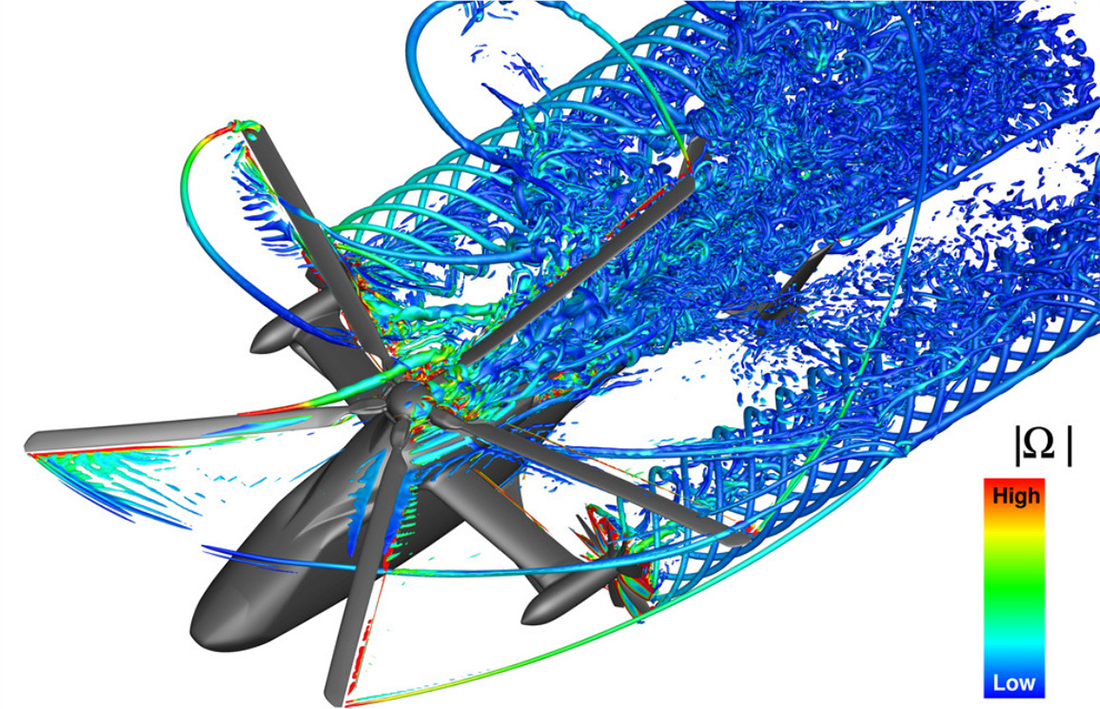ENGINEERING AND CFD
Numerical Simulation of Rotary Wing Aerodynamics, Aeroelasticity and Aeroacoustics (HELISIM)
Principal Investigator:
Manuel Keßler
Affiliation:
Institut für Aerodynamik und Gasdynamik, Universität Stuttgart (Germany)
Local Project ID:
HELISIM
HPC Platform used:
Hazel Hen of HLRS
Date published:
The helicopter and aeroacoustics group at IAG has simulated the complex aerodynamics and aeromechanics of rotorcraft since the early 1990s. Starting from non-viscous flow simulations on isolated rotors, simulation technology improved steadily over the years, including structural dynamics coupling, turbulence modelling, trim, and acoustics, up to the full helicopter configuration simulations possible today, which include the tail rotor and fuselage as well as consideration of the engine flow.
The grand challenge related to current simulation is the combination of highly sophisticated numerical algorithms for different physical phenomena (various flow features, bi-directional coupling to structure dynamics, acoustics) applied to engineering-relevant, very complex, realistic geometry configurations. Depending on the flight state, some ten revolutions of the rotor are required until the solution is fully converged to free flight conditions. This is a consequence of the fluid-structure coupling at the rotor blades—and, depending on simulation goals, the fuselage – and the corresponding changes in steering controls to establish stationary flight without residual forces.
Today, the steady increase in available computing power allows for simulation setups beyond 100 million computational cells with sixth-order accuracy to be run routinely, and, in special cases, up to half a billion cells. The largest of these simulations can consume up to 20 million core-hours of computing resources on the HLRS HPC system Hazel Hen, for a single flight state. Of course, not all problems require such enormous effort in order to be solved, and many questions can be answered quite satisfactorily with much less complex setups and even low fidelity models.
Current investigations range from deep analyses of fundamental aerodynamic phenomena like dynamic stall on the retreating blade to surveys over a broad spectrum of flight states over the full flight envelope of new configurations, to reduce flight mechanical risks. The close connection of a helicopter's components with their respective interaction necessitates using the most advanced simulation technology to solve many engineering-relevant questions. Recently, the group was able to simulate the first robust representation of the so-called tail-shake phenomenon—an interference between the aerodynamic wake of the rotor and upper fuselage and the tail boom with its elastic behaviour—with a high-fidelity framework, in good accordance with flight tests. Such results of the working group generated within the HELISIM project are truly unique and mark the forefront of international research in the entire helicopter aeromechanics community.
The simulation technology developed and advanced in the helicopter group of IAG helps to understand such phenomena, the influence of relevant parameters and the underlying physics. Furthermore, flow data is delivered in much more detail than in wind tunnel experiments and flight tests, providing deeper physical insight. At the end, this knowledge enables the development of safer, better performing, more efficient helicopters.
Scientific Contact:
Dr. Manuel Keßler, Dipl.-Phys.
Institut für Aerodynamik und Gasdynamik
Universität Stuttgart
Pfaffenwaldring 21, D-70550 Stuttgart (Germany)
e-mail: kessler [@] iag.uni-stuttgart.de
Website: Helicopter and Aero Acoustics Group, IAG, University of Stuttgart
Local project ID: HELISIM
July 2018
